Ceejay Writer: Welcome one and all to the May Aether Salon!
Ceejay Writer: If you are new to Salon, I’d first like to say, welcome. We’re happy you are here! For your relaxation and comfort, you’re welcome to haul a wearable seat out of your inventory, or a pillow to sit on the floor. If you need a chair, just private IM me and I will give you a wearable salon chair.
Ceejay Writer: Sera Puchkina is the Librarian of the R.F. Burton Library, and a gracious hostess in giving the Salon free rein of the library. A brave, brave woman she is. She stayed up late last night baking blueberry cheesecake and cookies for us. They are on the snack table along with absinthe, iced tea, and tequila shooters, so come on, get happy!
Ceejay Writer: Oriella Charik and the Duchess of Trikassi have led many salons over the years, and are always welcome to bring their knowledge to Salon. As an American, I always enjoy learning more about British traditions. Today should be no exception.
Ceejay Writer: In fact, I’m wondering if you might confirm that King Charles actually farted in the middle of his coronation, but no one said anything about it, since noble gases don’t cause a reaction.
Ceejay Writer: I’m so sorry. 😀 I’ll hush now. Please welcome two of Salon’s favorite daughters! Take it away, Oriella Charik and the Duchess of Trikassi!
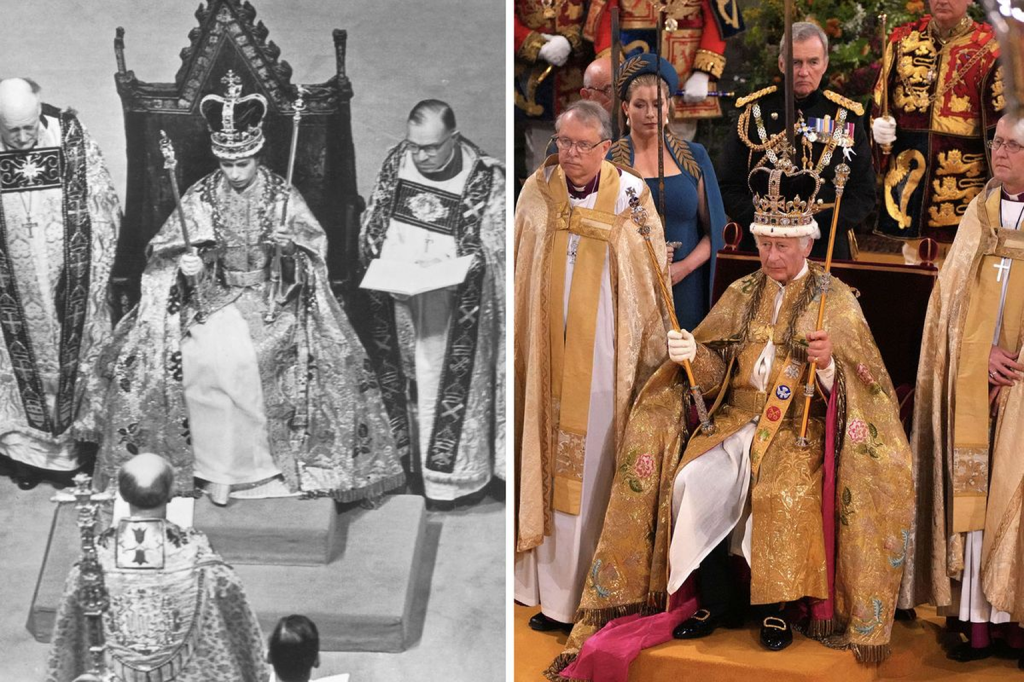
Liz Wilner: A preemptive apology to any Scots present – this lecture concerns English coronations! The two did not become one and the same until the 17th century.
Liz Wilner: The first English coronation was that of King Edgar the Peaceful (c. 943 – 975) who was crowned at Bath on 11 May 973 with his wife Ælfthryth. This was the first such ceremony in England intended to gain recognition of the King from his subjects and his neighbouring rulers.
Liz Wilner: The ceremony was devised by Saint Dunstan based on those used by Frankish kings and in the ordination of bishops. Several versions of coronation services, known as ordines or recensions have evolved over time since then.
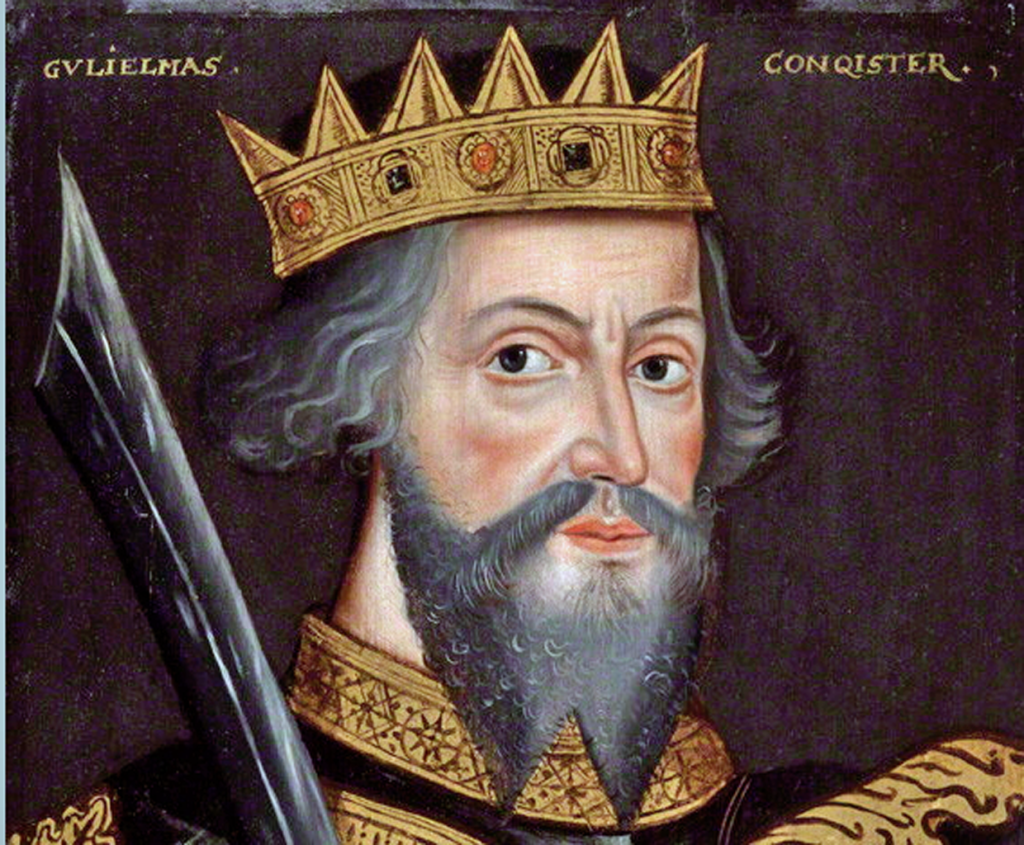
Liz Wilner: When William of Normandy seized the crown from the usurper Harold Godwinson in 1066, he decided upon a crowning at Westminster Abbey, newly constructed by the late King Edward the Confessor. He was not to know that the Abbey would be used for this purpose for the next thousand years by his successors.
Liz Wilner: It was Christmas Day, it was snowing, and it was not a joyous affair. To symbolise William’s Norman heritage and promote unity, both Saxon and Norman rites were used during the ceremony, with the bishops speaking English as well as French.
Liz Wilner: We have a detailed description of the ceremony by Guy, bishop of Amiens in the finale of his epic poem, Carmen de Hastingae Proelio (“Song of the Battle of Hastings”), which was probably written in 1067.
Liz Wilner: According to Guy, the ceremony began with a procession from the Palace of Westminster, also founded by Edward, to the Abbey.
Liz Wilner: In the procession, headed by a crucifer and accompanied by the chanting of the Lauds, William was preceded by the two leading churchmen of England, the archbishop of Canterbury, Stigand, and the archbishop of York, Ealdred.
Liz Wilner: It would be Ealdred who would officiate at the coronation, because Stigand had been inconveniently excommunicated by the Pope.
Liz Wilner: Once inside the church, William was conducted to a raised dais, described by Guy as a pulpitum, probably located at the crossing beneath the central tower.
Liz Wilner: This innovation, intended to physically and symbolically raise the king above his subjects, has been repeated at every coronation since.
Liz Wilner: The ceremony began with the nobles being asked in French whether they accepted the new king “by your free choice”, which was repeated in English by Ealdred.
Liz Wilner: The resulting acclamations were mistaken by Norman soldiers outside for a riot, to which they responded by setting fire to nearby houses; in the chaos, some soldiers began to fight the fire, others went looting.
Liz Wilner: Inside, the liturgy continued with the king and all the bishops prostrating themselves before the high altar while the Kyrie was chanted, followed by the anointing with oil of chrism.
Liz Wilner: William then took the oath, in which he promised “that he would rule all this people as well as the best of kings before him, if they would be loyal to him”.
Liz Wilner: Queen Matilda’s coronation was held later, on Whit Sunday. Following that coronation a state banquet was held, during which the King’s Champion, Baron Marmion, challenged anyone who denied that William and Matilda were the rightful king and queen to trial by combat.
Liz Wilner: During the ‘Anarchy’ (1138-1153), an uncivil war between the Conqueror’s grandson Stephen and his granddaughter Matilda, the latter booked a coronation but was driven from London by hostile crowds.
Liz Wilner: A Queen Regnant was not to be crowned until Queen Mary I in 1553.

Liz Wilner: The Abbey’s role as a coronation church influenced Henry III’s rebuilding of the church in the Gothic style of architecture from AD 1245 and a large space or “theatre” was planned under the lantern, between the quire and the high altar.
Liz Wilner: The first king to be crowned in the present Abbey was Edward I in 1274.
Liz Wilner: There have been 38 coronations held at the Abbey.
Liz Wilner: Two English rulers missed out: Edward V who was presumed murdered in the Tower of London and Edward VIII who abdicated before they could be crowned. Much as we would like to give account to them all, we will skip forward to modern times.

Liz Wilner: William III and Mary II were the only joint monarchs to be crowned and the chair pictured specially made for Mary’s use in 1689 is on view in the Abbey.
Liz Wilner: They were cousins and grandchildren of James I.

Liz Wilner: Queen Anne, last of the Stuart monarchs, was crowned on April 23rd, 1702.
Liz Wilner: The picture is a contemporary wax effigy. Being too lame to walk due to gout Yeomen of the guard carried her to the Abbey in an open chair.
Oriella Charik: Brandy
Oriella Charik: She liked it a lot
Liz Wilner: Leaving the abbey on foot, ‘with obliging looks and bows to all that saluted her’, the Queen crossed to Westminster Hall where the coronation banquet was held and once more the Queen’s champion rode in on horseback to challenge anyone who denied the new monarch’s right to the crown to combat.
Liz Wilner: Prudently, no one did. Alas, this tradition is no longer followed.
Liz Wilner: In the 18th and 19th centuries, public spectacle sometimes overshadowed religious significance.
Liz Wilner: For the coronation of George II and his wife Caroline in 1727 George Frideric Handel was commissioned to write four new coronation anthems, one of which, Zadok the Priest, has been sung at British coronations ever since.
Liz Wilner: The coronation was budgeted at £8,720.
Liz Wilner: There were 140 invited foreign visitors, with four seats allocated for “those who sold Wine, Coffee &c. in the Abbey”.
Liz Wilner: There were also 60 seats for the choir and “the Private Musick”. Tickets for a front seat cost 10 guineas each. A total of 1,780 people were seated in the abbey.
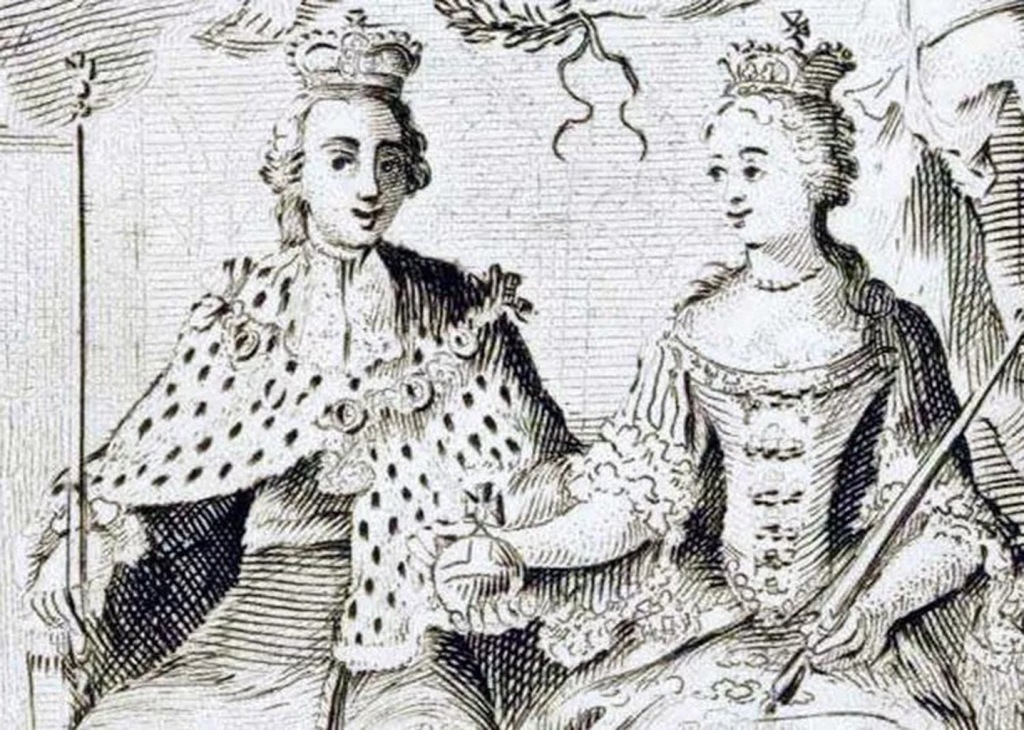
Liz Wilner: The coronation of George III and his wife Charlotte in 1761 was marked by errors and omissions.
Liz Wilner: The by then hereditary Earl Marshal, the Duke of Norfolk should have been in charge but being a Roman Catholic he was debarred and the task given to his Protestant relative the Earl of Effingham.
Liz Wilner: This exclusion has since been removed.
Liz Wilner: Before the procession to the Abbey it was discovered that the sword of state was missing, so one had to be borrowed from the Lord Mayor of London.
Solace Fairlady: Hence cardinal Nichols being allowed to attend
Liz Wilner: The Bishop of Rochester nearly dropped the crown he was carrying; fortunately it had been pinned to the cushion on which it sat.
Liz Wilner: One spectator noted that the heralds made “numerous mistakes and stupidities”, another that “the whole was confusion, irregularity and disorder”.
Liz Wilner: The King felt it inappropriate to take Communion wearing his crown, and asked the archbishop if it should be removed, the archbishop in turn asked the Dean of Westminster, but had to report that neither knew what the usual form was; the king removed his crown anyway.
Liz Wilner: At some point in the proceedings, a large jewel is reputed to have fallen from the crown, which was later said to have been an omen presaging American Independence.
Liz Wilner: During the sermon the congregation in the nave, who were unable to hear it, began to eat, mainly cold meat and pies, and drink wine brought with them and given out by servants; the ensuing clatter of cutlery resulted in an outburst of laughter.
Liz Wilner: When the Queen wanted to visit the “retiring-chamber” which had been constructed for her use in St Edward’s Chapel behind the high altar, she found it already occupied by the Duke of Newcastle, the prime minister, who was making use of the queen’s close stool.
Liz Wilner: Being 17 and having only met and married her husband two weeks previously she perhaps saw this as just another example of English eccentricity.
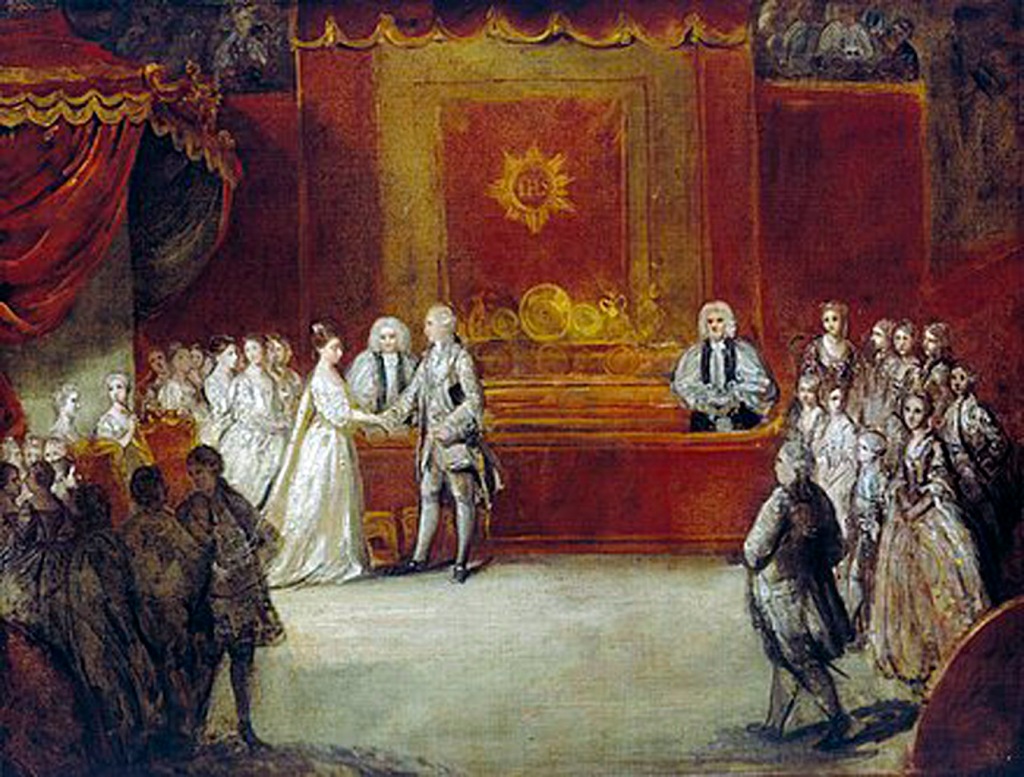
Oriella Charik: The picture is of the wedding
Liz Wilner: Afterwards when the King complained to Effingham about these problems, he admitted that there had been “some neglect”, but that he would make sure that the next coronation would be organised properly.
Liz Wilner: The King was highly amused by the answer and made Effingham repeat it several times.

Liz Wilner: George IV’s coronation was a great theatrical occasion but he flatly refused to allow his estranged wife Caroline to enter the Abbey. The two had despised each other from the moment they met.
Liz Wilner: On 19 July 1821, Caroline arrived at Westminster Abbey for her husband’s coronation despite being told to stay away.
Liz Wilner: The crowds gathered were in support of Caroline and watched as she was barred entry at several entrances – our illustration may be over dramatized!
Liz Wilner: She died two weeks later, but not before allegedly penning a mournful poem:
‘An injured Princess, justice is my claim
A helpless woman, pity is my due.’
‘Ah, good my Lord, what is the dire pretence
that draws your high displeasure on my head
witness this heart unconscious of offence
witness the blameless life I still have led!’
Liz Wilner: William IV had to be persuaded to have a coronation at all and spent so little money on it that it became known as ‘the penny coronation’.
Liz Wilner: And that brings us to Queen Victoria.

Liz Wilner: She fared no better than her predecessors, though as she was just 18 she cannot be blamed.
Liz Wilner: The event had not been properly practiced, so that – in the words of Benjamin Disraeli – the participants ‘were always in doubt as to what came next’.
Liz Wilner: While approaching Queen Victoria to give homage, a peer named Lord Rolle lived up to his name by falling and – in Victoria’s own words – rolling ‘quite down’ some steps.
Liz Wilner: The Archbishop shoved the coronation ring onto the wrong finger causing Victoria ‘great pain’ when she tried to pull it off afterwards, and at one point she mistakenly got up to leave thinking the ceremony was over.
Liz Wilner: Despite it all, Victoria later wrote that she would ‘remember this day as the proudest of my life!’
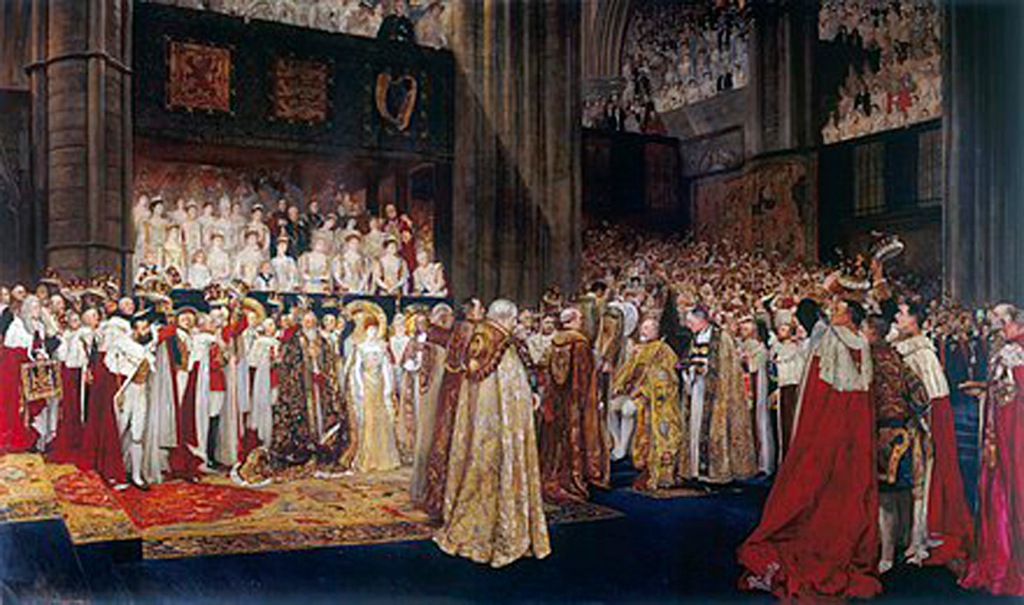
Liz Wilner: The coronation of Edward VII and his wife Alexandra was scheduled for June 1902, but the King fell ill just days before from appendicitis, a potentially lethal predicament that required urgent surgery.
Liz Wilner: This was carried out in the music room at Buckingham Palace, and it went so well that the king was happily up and puffing a cigar the next day.
Liz Wilner: The trouble was, many foreign dignitaries had already arrived in Britain for the cancelled coronation, and most of them would not return when the big event finally took place in August.
Ming Veritas: wonder what they had to do to get it off
Oriella Charik: Victoria describes it in her diary
Liz Wilner: Leading the ceremony was an ailing, near-blind Archbishop of Canterbury who had to have prayers printed on cue cards in gigantic type, but still misread some of them.
Liz Wilner: He also placed the crown back-to-front on the king’s head, and at one point told a concerned colleague to ‘Go away!’ loudly enough for the congregation to hear.
Liz Wilner: Otherwise everything went according to plan, and it is upon this coronation that subsequent ones have been based.
Liz Wilner: Upon their return to Buckingham Palace for example the King and Queen appeared on the balcony to greet the crowds.
Liz Wilner: All arrangements for coronation ceremonies are made by the Earl Marshal and his Coronation Committee on behalf of the Crown and not by the Abbey authorities.
Liz Wilner: But the Dean of Westminster instructs the sovereign on all matters connected with the service and assists the Archbishop of Canterbury, who always crowns the monarch assisted by the Archbishop of York.
Liz Wilner: Since the late 14th century every coronation ceremony has basically followed the same order of service laid down in the Abbey’s magnificent medieval illuminated Latin manuscript, the Liber Regalis, which can be viewed in the Galleries at the Abbey.
Liz Wilner: The coronation of Elizabeth I was a mixture of Latin and English but that of James I in 1603 was an entirely English liturgy.
Oriella Charik: The Pope can no longer excommunicate anyone
Solace Fairlady: Yes he can, just not in the C of E
Oriella Charik: anyone not Catholic that is!

Liz Wilner: The act of crowning takes place in the Coronation Chair, facing the High Altar, on the Cosmati mosaic pavement.
Liz Wilner: The chair was commissioned by Edward I, and it famously has beneath it the Stone of Scone, sat upon by Kings of Scots at their coronations.
Liz Wilner: It was kidnapped by Edward I, but now resides at Edinburgh castle and travels to London for coronations.
Oriella Charik: And that concludes our presentation
Liz Wilner: any questions?
Baron Klaus Wulfenbach: I heard the coronation chair is heavily graffitti’d.
Baron Klaus Wulfenbach: What can you tell us about that, bitte?
Liz Wilner: it was recently restored…as best it could be
Liz Wilner: The oak chair, also known as St Edward’s Chair, is considered one of the most precious pieces of furniture in the world and is the oldest piece of furniture in the UK which is still used for its original purpose.
Liz Wilner: Much of the graffiti on the inside of the chair’s backrest was carved by Westminster schoolboys and visitors to Westminster Abbey, during the 18th and 19th centuries, who left their initials or names.
Liz Wilner: One tourist carved “P. Abbott slept in this chair 5-6 July 1800” on the seat.
Liz Wilner: On the back of the chair was a painted king, either Edward the Confessor or Edward I, his feet resting on a lion. The four gilt lions that form the base were made in 1727 to replace the originals, which were not added until the early 16th century.
Liz Wilner: Slivers of wood were also cut off as souvenirs and during a 1914 bomb attack, thought to be the work of the suffragettes, a small corner was knocked off.
Oriella Charik: At least the Puritans didn’t burn it
Liz Wilner: the restorers used a replica Stone of Scone to approximate the weight for the needed repairs on the seat
Liz Wilner: or Charles would have fallen through the chair…LOL
Anabel Constabyl: Throughout history, people have been so impressed by what happened before their time, that they did what anyone would do in the face of wonder and beauty – they left graffiti.
Solace Fairlady: I loved the fact the King Charles Swordbearer is Penny Mordant
Baron Klaus Wulfenbach: Why so, Fraulein Solace?
Solace Fairlady: the last king of these isles to be given his sword by a woman was king Arthur by the lady of the lake
Baron Klaus Wulfenbach: Ahhh
Oriella Charik: Penny Mordant is Leader of the House of Commons, its agenda arranger that is, but oddly she gets to carry the sword
Solace Fairlady: She is Lord president of the privy Council
Solace Fairlady: thats why
Jedburgh Dagger: Farcical aquatic ceremonies are no basis for a government
Anabel Constabyl: “Strange women lying in ponds distributing swords is no basis for a system of government”! Or so I’ve heard.
Liz Wilner: Nika? do you have a question?
Nika Thought-werk asks as she smacks her lips, “Are there any special chocolate pieces made for these special times when new kings and queens are crowned?”
Oriella Charik: Gold commemorative medals were thrown into the crowd in Georgian times
Oriella Charik: Not alas with choclate
Nika Thought-werk shrugs “Gold is ok, I guess.”
Nika Thought-werk adds “Thank you.”
Anabel Constabyl: I agree with Nika. Chocolate would have been a nice touch.
Oriella Charik: My typist has a mug which was given to every child for Elizabeths coronation.
Ceejay Writer: Can’t heat gold and top it with marshmallows, though.
Liz Wilner: Ori was a wee child when Elizabeth the 2nd was crowned
OldeSoul Eldemar: King Charles III Coronation Milk Chocolate Slims. $6.99.
OldeSoul Eldemar: will be ordering later
Nika Thought-werk smacks her lips “Yes!”
Liz Wilner: nearly everyone tries to cash in on a Royal wedding or Coronation…with some souvenir!
Baron Klaus Wulfenbach: Someone surely minted chocolate coins.
Liz Wilner: I was brought a William & Kate tea towel from a friend
Solace Fairlady: Mugs are the traditional Coronation keepsake
Liz Wilner: and plates…fancy plates…and also matching tea cups and saucers
OldeSoul Eldemar: gotta pay for it all somehow
Liz Wilner: how many here watched the recent coronation?
Ceejay Writer: It’s a business!
Solace Fairlady: We had a tin mug from George’s coronation
Solace Fairlady: kept the fat from the sunday roast in it
SvargaFan: I did
Ceejay Writer: I’ve watched bits and pieces, but have the YouTube stream bookmarked for more watching.
Owlie Bonesworth: I did
Solace Fairlady: I did:)
Symeon Siamendes: I watched it
Liz Wilner: what did you think, Symeon?
Solace Fairlady: I even paid for a TV licence to watch it
Oriella Charik: I have one my mother was given
Symeon Siamendes: Interesting – very impressive
Ceejay Writer: https://www.youtube.com/live/IZMhuh0tZIE?feature=share
Symeon Siamendes: The Gospel choir was a nice new touch
Baron Klaus Wulfenbach: What did you Damen think of the Coronation?
Liz Wilner: I was fascinated
Liz Wilner: having not seen one live ever
Oriella Charik: It seemed to be better organised!
Liz Wilner: I have seent the old footage from QE2…but watching in real time was amazing
Baron Klaus Wulfenbach: What aspect appealed to you the most?
Liz Wilner: William & Kate’s children were very well behaved!
Liz Wilner: Charles was…4? when his mother was crowned…he fidgeted and was bored…LOL
Ceejay Writer: The kids really were.
Liz Wilner: the Queen Mum had to hush him a few times
Jedburgh Dagger: Sitting still that long with small kids is a big ask
Liz Wilner: it is
Ceejay Writer: It’s a LONG process for a kid to put up with.
Oriella Charik: I suspect Charles was thinking of his mother saying “you can’t be ANNOINTED in PUBLIC!!”
Liz Wilner: and in dress clothes too!
Baron Klaus Wulfenbach: Thank goodness for nannies and tutors….
Oriella Charik: Hence the screens

